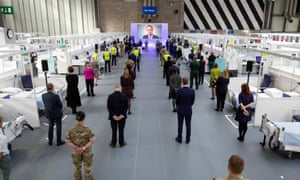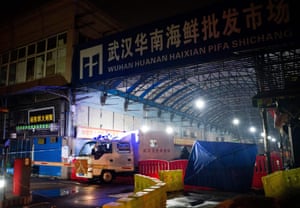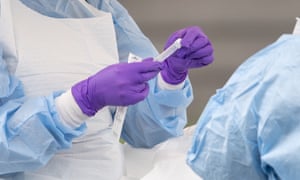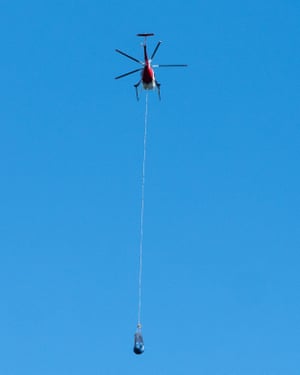By Associated Press April 17, 2020
FILE - protests on the front steps of the Michigan State Capitol building in Lansing, Mich., April 15, 2020.
While many Americans are filled with fear, Melissa Ackison says the coronavirus pandemic has filled her with anger. The stay-at-home orders are government overreach, the conservative Ohio state Senate candidate says, and the labeling of some workers as "essential" arbitrary.
"It enrages something inside of you," said Ackison, who was among those who protested Republican Gov. Mike DeWine's orders at the statehouse in Columbus with her 10-year-old son. She has "no fear whatsoever" of contracting the virus, she said Thursday, dismissing it as hype.
The Ohio protest was among a growing number staged outside governors' mansions and state Capitols across the country. In places like Oklahoma, Texas and Virginia, small-government groups, supporters of President Donald Trump, anti-vaccine advocates, gun rights backers and supporters of right-wing causes have united behind a deep suspicion of efforts to shut down daily life to slow the spread of the coronavirus. As their frustration with life under lockdown grows, they've started to openly defy the social distancing rules in an effort to put pressure on governors to ease them.
Some of the protests have been small events, promoted via Facebook groups that have popped up in recent days and whose organizers are sometimes difficult to identify. Others are backed by groups funded by prominent Republican donors, some with ties to Trump. The largest so far, a rally of thousands that jammed the streets of Lansing, Michigan, on Wednesday, looked much like one of the president's rallies — complete with MAGA hats or Trump flags — or one of the tea party rallies from a decade ago.

While many Americans are filled with fear, Melissa Ackison says the coronavirus pandemic has filled her with anger. The stay-at-home orders are government overreach, the conservative Ohio state Senate candidate says, and the labeling of some workers as "essential" arbitrary.
"It enrages something inside of you," said Ackison, who was among those who protested Republican Gov. Mike DeWine's orders at the statehouse in Columbus with her 10-year-old son. She has "no fear whatsoever" of contracting the virus, she said Thursday, dismissing it as hype.
The Ohio protest was among a growing number staged outside governors' mansions and state Capitols across the country. In places like Oklahoma, Texas and Virginia, small-government groups, supporters of President Donald Trump, anti-vaccine advocates, gun rights backers and supporters of right-wing causes have united behind a deep suspicion of efforts to shut down daily life to slow the spread of the coronavirus. As their frustration with life under lockdown grows, they've started to openly defy the social distancing rules in an effort to put pressure on governors to ease them.
Some of the protests have been small events, promoted via Facebook groups that have popped up in recent days and whose organizers are sometimes difficult to identify. Others are backed by groups funded by prominent Republican donors, some with ties to Trump. The largest so far, a rally of thousands that jammed the streets of Lansing, Michigan, on Wednesday, looked much like one of the president's rallies — complete with MAGA hats or Trump flags — or one of the tea party rallies from a decade ago.

FILE - Protesters rally against stay-at-home orders related to the coronavirus pandemic outside Capitol Square in Richmond, Virginia, April 16, 2020.
The signs of frustration come as Trump has pushed for easing stay-at-home orders and tried to look ahead to restarting the economy. He unveiled a framework for governors to follow on Thursday, but acknowledged the governors will have the final say on when their state is ready. Health experts have warned that lifting restrictions too quickly could result in a surge of new cases of the virus.
But the president and some of his supporters are impatient. Thousands of people in their cars packed the streets of Lansing to protest Democratic Gov. Gretchen Whitmer's stay-at-home order and other restrictions. Outside the Capitol, some chanted "Lock her up," a throwback to Trump's calls during the 2016 election about his rival Hillary Clinton. One woman held a sign reading "Heil Witmer."
Asked about the protesters, Trump on Thursday expressed sympathy with their frustration — "They're suffering ... they want to get back" — and dismissed concerns about the health risks of ignoring state orders and potentially exposing themselves to the virus.
"I think they're listening. I think they listen to me," he said. "They seem to be protesters that like me and respect this opinion, and my opinion's the same as just about all of the governors. Nobody wants to stay shut."
Polls show the protesters' views are not widely held. An AP-NORC survey earlier this month found large majorities of Americans support a long list of government restrictions, including closing schools, limiting gatherings, and shuttering bars and restaurants. Three-quarters of Americans backed requiring people to stay in their homes. And majorities of both Democrats and Republicans gave high marks for the state and city governments.
But the protests expose resilient partisan divisions, particularly in battleground Michigan. The protest there was organized by the Michigan Conservative Coalition, a group founded by a pro-Trump state representative and his wife, Meshawn Maddock, who is on the advisory board for an official Trump campaign group called "Women for Trump" and is also the co-founder of Michigan Trump Republicans. Their daughter is a field organizer for the Michigan Republican Party.

The signs of frustration come as Trump has pushed for easing stay-at-home orders and tried to look ahead to restarting the economy. He unveiled a framework for governors to follow on Thursday, but acknowledged the governors will have the final say on when their state is ready. Health experts have warned that lifting restrictions too quickly could result in a surge of new cases of the virus.
But the president and some of his supporters are impatient. Thousands of people in their cars packed the streets of Lansing to protest Democratic Gov. Gretchen Whitmer's stay-at-home order and other restrictions. Outside the Capitol, some chanted "Lock her up," a throwback to Trump's calls during the 2016 election about his rival Hillary Clinton. One woman held a sign reading "Heil Witmer."
Asked about the protesters, Trump on Thursday expressed sympathy with their frustration — "They're suffering ... they want to get back" — and dismissed concerns about the health risks of ignoring state orders and potentially exposing themselves to the virus.
"I think they're listening. I think they listen to me," he said. "They seem to be protesters that like me and respect this opinion, and my opinion's the same as just about all of the governors. Nobody wants to stay shut."
Polls show the protesters' views are not widely held. An AP-NORC survey earlier this month found large majorities of Americans support a long list of government restrictions, including closing schools, limiting gatherings, and shuttering bars and restaurants. Three-quarters of Americans backed requiring people to stay in their homes. And majorities of both Democrats and Republicans gave high marks for the state and city governments.
But the protests expose resilient partisan divisions, particularly in battleground Michigan. The protest there was organized by the Michigan Conservative Coalition, a group founded by a pro-Trump state representative and his wife, Meshawn Maddock, who is on the advisory board for an official Trump campaign group called "Women for Trump" and is also the co-founder of Michigan Trump Republicans. Their daughter is a field organizer for the Michigan Republican Party.

FILE - Vehicles sit in gridlock during a protest in Lansing, Mich., April 15, 2020.
Another group that promoted the event, the Michigan Freedom Fund, is run by Greg McNeilly, a longtime political adviser to the DeVos family, who are prolific Republican donors and have funded conservative causes across the state for decades. McNeilly was campaign manager for Dick DeVos, the husband of current U.S. Education Secretary Betsy DeVos, during his failed bid for governor in 2006. The group, which does not have to disclose its donors, raised over $4 million in 2018, according to its most recent tax statements.
Whitmer was among the governors who expressed concern about the gatherings, saying it put people at risk and could have prolonged the shutdown. Michigan had recorded over 2,000 deaths from COVID-19 as of Thursday, and close to 30,000 confirmed cases of people infected with the virus. Roughly one-quarter of the state's workforce has filed for unemployment.
But it's not just Democratic governors feeling the heat. A procession of cars swarmed around the Republican-dominated statehouse in Oklahoma City on Wednesday, with messages written on windows or signs that said "stop killing our economy," "we need our church" and "time 2 work."
Carol Hefner, who previously served as an Oklahoma co-chair of Trump's 2016 campaign, was a major organizer of the event. Hefner, whose husband is part of the Hefner Energy empire and currently operates a company that makes Argentinian meat sauce, differentiated it from many of the others, characterizing it as a "rally" rather than a protest.
"We're not New York. Their problems are not our problems," Hefner said. "We are rallying around our governor and our state to encourage the opening up of our businesses and the restoration of our state in a timely fashion."
Other gatherings have links to fringe groups. A protest Thursday in the Texas capital of Austin, where protesters chanted "Free Texas" and "Make America Free Again," was broadcast live by InfoWars TV, part of a company owned by conspiracy theorist and radio host Alex Jones.
FILE - Protesters from a grassroots organization called “REOPEN NC” demonstrate against the North Carolina coronavirus lockdown at a parking lot adjacent to the North Carolina State Legislature in Raleigh, North Carolina, April 14, 2020.
The Ohio event earlier this week brought together a collection of anti-vaccine advocates, Second Amendment supporters, tea party activists and other anti-government activists. A Columbus Dispatch photo of Ackison and other protesters yelling through glass doors of the statehouse rocketed around the internet.
Ackison said that while she views DeWine's efforts as constitutional overreach, she would be fine if Trump were to act with similar authority to force governors to bring the states back on line.
"As patriots, we put President Trump in office for a reason," she said. "If he's not able to give a convincing enough argument to these governors that they need to open up, then he needs to do something to take action."
The protests were advertised on Facebook by groups such as Reopen Virginia and End the Lockdown PA. A protest in Richmond, Virginia, on Thursday grew out of a conversation in the Facebook group Virginians for Medical Freedom, organizer Gary Golden said. The group often turns out at the Capitol in Richmond to oppose vaccine-related measures.
Kelly Mullin, who stood near a "don't tread on me" flag spread on the grass near the governor's mansion, said she brought her sons to the event to teach them a lesson about liberty.
Mullin said that she thought the risk posed by the coronavirus depends on an individual's health and that people can take basic steps to protect themselves, including getting enough sleep, eating organic produce and getting outside.
"I mean, that's where our tax dollars should be going. Eat broccoli," she said.
Infectious-disease specialists say there is no evidence that eating specific foods can prevent or kill the virus. Most people with the coronavirus experience mild or moderate symptoms, and people with health issues such as asthma and older people are at greater risk of death from COVID-19.
While many Americans are filled with fear, Melissa Ackison says the coronavirus pandemic has filled her with anger. The stay-at-home orders are government overreach, the conservative Ohio state Senate candidate says, and the labeling of some workers as "essential" arbitrary.
"It enrages something inside of you," said Ackison, who was among those who protested Republican Gov. Mike DeWine's orders at the statehouse in Columbus with her 10-year-old son. She has "no fear whatsoever" of contracting the virus.
 AFP / Joseph PreziosoHundreds of New Hampshire residents rallied outside the statehouse in Concord on April 18 to urge a quick end to the northeastern state's virus-related stay-at-home rule
AFP / Joseph PreziosoHundreds of New Hampshire residents rallied outside the statehouse in Concord on April 18 to urge a quick end to the northeastern state's virus-related stay-at-home rule
 AFP / Mark FelixFar-right conspiracy theorist Alex Jones addresses a "Reopen America" rally at the State Capitol in Austin, Texas
AFP / Mark FelixFar-right conspiracy theorist Alex Jones addresses a "Reopen America" rally at the State Capitol in Austin, Texas
 AFP / SAUL LOEBDemonstrators protest from their cars in Annapolis, Maryland
AFP / SAUL LOEBDemonstrators protest from their cars in Annapolis, Maryland
 AFP / Mark FelixA protester holds up a sign during the "Reopen America" rally in Austin, Texas
AFP / Mark FelixA protester holds up a sign during the "Reopen America" rally in Austin, Texas
 AFP / Megan JELINGERProtesters rally at the Ohio State House in Columbus
AFP / Megan JELINGERProtesters rally at the Ohio State House in Columbus
 AFP / Joseph PreziosoA protester in Concord, New Hampshire waves a flag during a rally urging a quick end to virus-related confinement rules
AFP / Joseph PreziosoA protester in Concord, New Hampshire waves a flag during a rally urging a quick end to virus-related confinement rules
 AFP / Joseph PreziosoSome at the Concord, New Hampshire rally against home confinement rules wore masks or face coverings
AFP / Joseph PreziosoSome at the Concord, New Hampshire rally against home confinement rules wore masks or face coverings
Another group that promoted the event, the Michigan Freedom Fund, is run by Greg McNeilly, a longtime political adviser to the DeVos family, who are prolific Republican donors and have funded conservative causes across the state for decades. McNeilly was campaign manager for Dick DeVos, the husband of current U.S. Education Secretary Betsy DeVos, during his failed bid for governor in 2006. The group, which does not have to disclose its donors, raised over $4 million in 2018, according to its most recent tax statements.
Whitmer was among the governors who expressed concern about the gatherings, saying it put people at risk and could have prolonged the shutdown. Michigan had recorded over 2,000 deaths from COVID-19 as of Thursday, and close to 30,000 confirmed cases of people infected with the virus. Roughly one-quarter of the state's workforce has filed for unemployment.
But it's not just Democratic governors feeling the heat. A procession of cars swarmed around the Republican-dominated statehouse in Oklahoma City on Wednesday, with messages written on windows or signs that said "stop killing our economy," "we need our church" and "time 2 work."
Carol Hefner, who previously served as an Oklahoma co-chair of Trump's 2016 campaign, was a major organizer of the event. Hefner, whose husband is part of the Hefner Energy empire and currently operates a company that makes Argentinian meat sauce, differentiated it from many of the others, characterizing it as a "rally" rather than a protest.
"We're not New York. Their problems are not our problems," Hefner said. "We are rallying around our governor and our state to encourage the opening up of our businesses and the restoration of our state in a timely fashion."
Other gatherings have links to fringe groups. A protest Thursday in the Texas capital of Austin, where protesters chanted "Free Texas" and "Make America Free Again," was broadcast live by InfoWars TV, part of a company owned by conspiracy theorist and radio host Alex Jones.
FILE - Protesters from a grassroots organization called “REOPEN NC” demonstrate against the North Carolina coronavirus lockdown at a parking lot adjacent to the North Carolina State Legislature in Raleigh, North Carolina, April 14, 2020.
The Ohio event earlier this week brought together a collection of anti-vaccine advocates, Second Amendment supporters, tea party activists and other anti-government activists. A Columbus Dispatch photo of Ackison and other protesters yelling through glass doors of the statehouse rocketed around the internet.
Ackison said that while she views DeWine's efforts as constitutional overreach, she would be fine if Trump were to act with similar authority to force governors to bring the states back on line.
"As patriots, we put President Trump in office for a reason," she said. "If he's not able to give a convincing enough argument to these governors that they need to open up, then he needs to do something to take action."
The protests were advertised on Facebook by groups such as Reopen Virginia and End the Lockdown PA. A protest in Richmond, Virginia, on Thursday grew out of a conversation in the Facebook group Virginians for Medical Freedom, organizer Gary Golden said. The group often turns out at the Capitol in Richmond to oppose vaccine-related measures.
Kelly Mullin, who stood near a "don't tread on me" flag spread on the grass near the governor's mansion, said she brought her sons to the event to teach them a lesson about liberty.
Mullin said that she thought the risk posed by the coronavirus depends on an individual's health and that people can take basic steps to protect themselves, including getting enough sleep, eating organic produce and getting outside.
"I mean, that's where our tax dollars should be going. Eat broccoli," she said.
Infectious-disease specialists say there is no evidence that eating specific foods can prevent or kill the virus. Most people with the coronavirus experience mild or moderate symptoms, and people with health issues such as asthma and older people are at greater risk of death from COVID-19.
While many Americans are filled with fear, Melissa Ackison says the coronavirus pandemic has filled her with anger. The stay-at-home orders are government overreach, the conservative Ohio state Senate candidate says, and the labeling of some workers as "essential" arbitrary.
"It enrages something inside of you," said Ackison, who was among those who protested Republican Gov. Mike DeWine's orders at the statehouse in Columbus with her 10-year-old son. She has "no fear whatsoever" of contracting the virus.
Hundreds protest against US virus rules
 AFP / Joseph PreziosoHundreds of New Hampshire residents rallied outside the statehouse in Concord on April 18 to urge a quick end to the northeastern state's virus-related stay-at-home rule
AFP / Joseph PreziosoHundreds of New Hampshire residents rallied outside the statehouse in Concord on April 18 to urge a quick end to the northeastern state's virus-related stay-at-home rule
Hundreds protested Saturday in cities across America against coronavirus-related lockdowns -- with encouragement from President Donald Trump -- as resentment grows against the crippling economic cost of confinement.
An estimated 400 people gathered under a cold rain in Concord, New Hampshire -- many on foot while others remained in their cars -- to send a message that extended quarantines were not necessary in a state with relatively few confirmed cases of COVID-19.
The crowd included several armed men wearing military-style uniforms, with their faces covered.
 AFP / Mark FelixFar-right conspiracy theorist Alex Jones addresses a "Reopen America" rally at the State Capitol in Austin, Texas
AFP / Mark FelixFar-right conspiracy theorist Alex Jones addresses a "Reopen America" rally at the State Capitol in Austin, Texas
In Texas, more than 250 people rallied outside the State Capitol in Austin, including far-right conspiracy theorist Alex Jones, founder of the Infowars site, who rolled up in a tank-like truck.
"It's time to reopen Texas, it's time to let people work, it's time for them to let voluntary interaction and good sense rule the day, not government force," said Justin Greiss, an activist with Young Americans for Liberty.
Stay-at-home mother Amira Abuzeid added: "I'm not a doctor but I'm an intelligent person who can do math and it looks like at the end of the day, these numbers are not that worrisome."
Few if any observed social distancing recommendations.
Demonstrators outside Maryland's colonial-era statehouse in Annapolis stayed in their cars but waved signs with messages like "Poverty kills too."
 AFP / SAUL LOEBDemonstrators protest from their cars in Annapolis, Maryland
AFP / SAUL LOEBDemonstrators protest from their cars in Annapolis, Maryland
Dolores, a hairdresser, told AFP she is not eligible for unemployment because she is a business owner, not an employee.
"I need to save my business. I need to work to live. Otherwise I will die," she said.
Other demonstrations took place across the country in cities such as Columbus, Ohio and San Diego, California, as well as the states of Indiana, Nevada and Wisconsin.
Few practiced social distancing but many of the protesters waved American flags.
- 'Live Free or Die' -
Protesters have drawn encouragement in certain Democratic-led states from tweets by Trump, who has said he favors a quick return to normal, though protests have also taken place in Republican-led states like New Hampshire and Texas.
 AFP / Mark FelixA protester holds up a sign during the "Reopen America" rally in Austin, Texas
AFP / Mark FelixA protester holds up a sign during the "Reopen America" rally in Austin, Texas
The US has seen more coronavirus cases and deaths than any other country in the world -- with more than 734,000 confirmed infections and 38,800 fatalities as of Saturday evening.
The vast majority of Americans are under lockdown orders restricting public movement and keeping all but essential businesses closed.
In Concord, demonstrators carried signs with slogans like "The numbers lie" and "Reopen New Hampshire."
Their common demand was that the stay-at-home order for the state of 1.3 million people be called off before its scheduled May 4 end date.
 AFP / Megan JELINGERProtesters rally at the Ohio State House in Columbus
AFP / Megan JELINGERProtesters rally at the Ohio State House in Columbus
Others, amid a sea of American flags, chanted the state's Revolutionary War-era slogan, "Live Free or Die."
"People are very happy on a voluntary basis to do what's necessary," one demonstrator, 63-year-old Skip Murphy, told AFP by phone.
He added, however, that "the data does not support the egregious lockdown we are having in New Hampshire."
As of early Friday, New Hampshire had reported 1,287 confirmed coronavirus cases and 37 deaths.
- 'Free country' -
"All over the country, a lot of people are saying, 'We will do our part, but at the same time, this is supposed to be a free country,'" Murphy said.
 AFP / Joseph PreziosoA protester in Concord, New Hampshire waves a flag during a rally urging a quick end to virus-related confinement rules
AFP / Joseph PreziosoA protester in Concord, New Hampshire waves a flag during a rally urging a quick end to virus-related confinement rules
"When that gets transgressed, people start to say, 'Wait a minute, this is wrong.'"
Most Americans -- by a two-to-one margin -- actually worry about virus restrictions being lifted too soon, not too late, a recent Pew survey found.
But demonstrators found encouragement Friday from the president, who in a series of tweets called to "LIBERATE" Michigan, Minnesota and Virginia -- all states with Democratic governors -- from stay-at-home orders.
Trump has repeatedly called for the earliest possible return to normality as virus-related closings have had a crushing impact on American workers and businesses.
 AFP / Joseph PreziosoSome at the Concord, New Hampshire rally against home confinement rules wore masks or face coverings
AFP / Joseph PreziosoSome at the Concord, New Hampshire rally against home confinement rules wore masks or face coverings
"I really think some of the governors have gotten carried away," Trump said at a White House news conference on Saturday.
He welcomed the reopening of some businesses in Texas and Vermont on Monday "while still requiring appropriate social distancing precautions."
The largest protest against stay-at-home rules so far took place Wednesday in the Michigan capital of Lansing, which drew some 3,000 people.
Murphy said he had voted for Trump, but insisted his motives were not partisan. New Hampshire Governor Chris Sununu is a Republican, he noted.
"This has nothing to do with Trump or the Democratic and Republican governors," Murphy said.
"It is a case of one size not fitting all -- the lockdown should cease where it does not make sense."
---30---
















